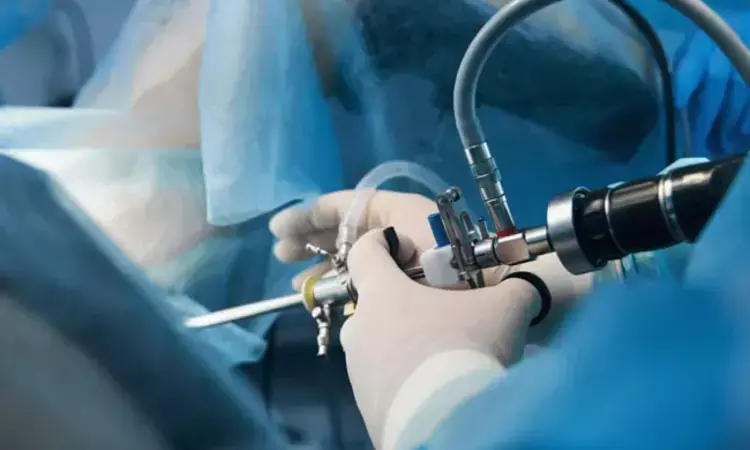- Home
- Medical news & Guidelines
- Anesthesiology
- Cardiology and CTVS
- Critical Care
- Dentistry
- Dermatology
- Diabetes and Endocrinology
- ENT
- Gastroenterology
- Medicine
- Nephrology
- Neurology
- Obstretics-Gynaecology
- Oncology
- Ophthalmology
- Orthopaedics
- Pediatrics-Neonatology
- Psychiatry
- Pulmonology
- Radiology
- Surgery
- Urology
- Laboratory Medicine
- Diet
- Nursing
- Paramedical
- Physiotherapy
- Health news
- Fact Check
- Bone Health Fact Check
- Brain Health Fact Check
- Cancer Related Fact Check
- Child Care Fact Check
- Dental and oral health fact check
- Diabetes and metabolic health fact check
- Diet and Nutrition Fact Check
- Eye and ENT Care Fact Check
- Fitness fact check
- Gut health fact check
- Heart health fact check
- Kidney health fact check
- Medical education fact check
- Men's health fact check
- Respiratory fact check
- Skin and hair care fact check
- Vaccine and Immunization fact check
- Women's health fact check
- AYUSH
- State News
- Andaman and Nicobar Islands
- Andhra Pradesh
- Arunachal Pradesh
- Assam
- Bihar
- Chandigarh
- Chattisgarh
- Dadra and Nagar Haveli
- Daman and Diu
- Delhi
- Goa
- Gujarat
- Haryana
- Himachal Pradesh
- Jammu & Kashmir
- Jharkhand
- Karnataka
- Kerala
- Ladakh
- Lakshadweep
- Madhya Pradesh
- Maharashtra
- Manipur
- Meghalaya
- Mizoram
- Nagaland
- Odisha
- Puducherry
- Punjab
- Rajasthan
- Sikkim
- Tamil Nadu
- Telangana
- Tripura
- Uttar Pradesh
- Uttrakhand
- West Bengal
- Medical Education
- Industry
Hysteroscopic diagnostic criteria precise in detecting chronic endometritis: Study

A new study published in the American Journal of Obstetrics and Gynecology found the hysteroscopic diagnostic criteria to be highly sensitive and reliable for identifying chronic endometritis.
Chronic endometritis (CE) is characterized by ongoing inflammation of the uterine mucosa. The microscopic detection of plasma cells in the endometrial stroma is a characteristic of this disease. Although few cases of abacterial CE have been reported, several bacteria, mostly gram-negative and intracellular (including Enterococcus faecalis, Escherichia coli, urea-plasma, Mycoplasma, Chlamydia, and Streptococcus spp.), have been linked to the development of CE.
The gold standard method for diagnosing and treating endocervical and intracavitary lesions is hysteroscopy. Thus, to evaluate the diagnostic accuracy of current hysteroscopic criteria in comparison to histological examination (with or without supplementary immunohistochemistry) for the diagnosis of chronic endometritis, Gaetano Riemma and colleagues carried out this study.
The diagnostic accuracy of hysteroscopy for chronic endometritis was assessed by comparing hysteroscopic criteria with histological (with or without immunohistochemistry) diagnosis. Studies were chosen based on whether they were prospective, retrospective, or randomized. The diagnostic odds ratio, sensitivity, specificity, and area under the summary receiver operating characteristic curve were the main results. Secondary outcomes included both positive and negative probability ratios.
In accordance with the Synthesizing Evidence from Diagnostic Accuracy Tests methodological standards and the Preferred Reporting Items for Systematic Reviews and Meta-Analyses recommendations, a diagnostic accuracy meta-analysis was carried out. The Quality Evaluation Tool for Diagnostic Accuracy Studies−2 (QUADAS-2) was used to perform the quality evaluation. Using the Deeks funnel plot asymmetry test, publication bias was assessed.
A total of 13 investigations compared the histological examination of endometrial samples with the existing hysteroscopic criteria. The diagnostic odds ratio, after combining all the investigations, was 40. With a very good diagnostic accuracy, the assessed area under the summary receiver operating characteristic curve was 0.93. The corresponding sensitivity and specificity were 84% and 89%. Also, the probability ratios for good and negative outcomes were 7.4 and 0.19, respectively.
Overall, hysteroscopic diagnostic criteria are very sensitive and accurate for the detection of chronic endometritis. If there is no hysteroscopic suspicion, the illness may be ruled out. However, because hysteroscopy alone carries a risk of false positives, endometrial biopsy is advised to confirm the diagnosis in situations where hysteroscopic diagnostic signs of chronic endometritis are present.
Reference:
Riemma, G., Parry, J. P., De Franciscis, P., Carugno, J., Lettieri, D., Cobellis, L., Vitagliano, A., Etrusco, A., Lin, L.-T., Angioni, S., & Vitale, S. G. (2025). Hysteroscopic criteria for the diagnosis of chronic endometritis: A systematic review and diagnostic test accuracy meta-analysis. American Journal of Obstetrics and Gynecology. https://doi.org/10.1016/j.ajog.2025.03.005
Neuroscience Masters graduate
Jacinthlyn Sylvia, a Neuroscience Master's graduate from Chennai has worked extensively in deciphering the neurobiology of cognition and motor control in aging. She also has spread-out exposure to Neurosurgery from her Bachelor’s. She is currently involved in active Neuro-Oncology research. She is an upcoming neuroscientist with a fiery passion for writing. Her news cover at Medical Dialogues feature recent discoveries and updates from the healthcare and biomedical research fields. She can be reached at editorial@medicaldialogues.in
Dr Kamal Kant Kohli-MBBS, DTCD- a chest specialist with more than 30 years of practice and a flair for writing clinical articles, Dr Kamal Kant Kohli joined Medical Dialogues as a Chief Editor of Medical News. Besides writing articles, as an editor, he proofreads and verifies all the medical content published on Medical Dialogues including those coming from journals, studies,medical conferences,guidelines etc. Email: drkohli@medicaldialogues.in. Contact no. 011-43720751


